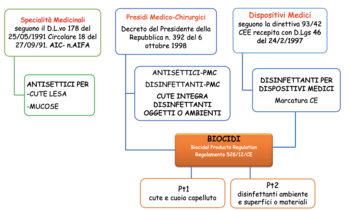- IT
- |
- EN

[Last update: February 2021]
The antisepsis and disinfection procedure is one of the cornerstones of general hygiene; the correct application allows to control the infectious risk and to stop the transmission of pathogens to patients, operators, objects and the environment. [1] [2] [3]
The chemicals used for this purpose exert a microbicidal action towards infectious agents and are divided into Specialty Medications, Medical Surgical Presidium-PMC and Medical Devices and/or Biocides, classified according to scheme 1 (SIFO, 2015). [4] Biocidal products and/or PMCs include antiseptics (products used on intact skin) and disinfectants (products used for objects, surfaces, environment) while antiseptic drugs are used on injured or mucous skin (e.g. ulcers, urinary meatus, oral cavity). [5] [6]
The proper use of antisepsis and disinfection is part of the overall strategy for the reduction of healthcare-associated infections - HAI and surgical site infections. [7] [8]
It is necessary to use products that possess and demonstrate the efficacy (according to the EN UNI specific technical standards) [9], of the required activity (virucidal, bactericidal, sporicidal), also taking into account the necessary contact times, the different substrates and the possible interfering means in which infectious agents are present, since the microbicidal properties may be insufficient, cancelled or greatly reduced.
- Biocidal product: capable of destroying harmful organisms, or otherwise capable of making them harmless, by chemical/biological processes, and not by physical or mechanical action alone (Article 3 of Regulation (EU) No. 528/2012).
- Disinfection activities: activities relating to the complex of procedures and operations to make disinfected confined spaces, areas of relevance and surfaces, by destroying or inactivating pathogenic micro-organisms (ISS Report No 19).
- Antisepsis: a process aimed at the elimination/inactivation of infectious agents on the skin, whole or injured, or on the mucous membranes.
- Disinfection: The process by which most micro-organisms, but not spores, are removed/inactivated from non-biological surfaces and inanimate objects.
- Cleaning: removal of foreign material (dirt, organic material, etc.) from objects, surfaces, skin, mucous membranes.
- Detergent: Article 2.1 of Regulation (EC) No 648/2004 defines "detergent": "any substance or mixture containing soaps and/or other surfactants, intended for washing and cleaning activities" (ISS No 19). The cleansing and/or cleaning procedure reduces the number of microorganisms, removes the material and facilitates the penetration of the active substance, must precede antisepsis and disinfection.
[1]. RutalaW.A, Weber D.J. and the Healthcare Infection Control Practices AdvisoryCommittee (HICPAC). Guideline for Disinfection and Sterilisation in HealthcareFacilities, 2008. Update may 2019. https://www.cdc.gov/infectioncontrol/pdf/guidelines/disinfection-guidelines-H.pdf
[2]. ANMDO. Linee Guida per il corretto utilizzo degli antisettici –disinfettanti. Marzo 2009
[3]. Regione Emilia Romagna. MEMO_6. Antisepsi e disinfezione in ambitosanitario. Aprile 2011
[4]. SIFO. Linee di indirizzo tecnico La disinfezione, gli adempimenti dellavigente legislazione e i criteri di scelta di formulazioni ed apparecchiatureche espletano attività disinfettante. Società Italiana di Farmacia Ospedalierae dei Servizi Farmaceutici Territoriali. ISBN 978-8-86528-© 2015 by Edizioni IlCampano.
[5]. Rapporto ISS COVID-19 · n. 19/2020 Rev Raccomandazioni ad interim suidisinfettanti nell’attuale emergenza COVID-19: presidi medico chirurgici ebiocidi Gruppo di lavoro ISS Biocidi COVID-19
[6]. Rutala W.A, Weber D.J. Selection of the idealdisinfectant. InfectControl Hosp Epidemiol. 2014 Jul;35(7):855-65. doi: 10.1086/676877. Epub 2014May 29. PubMed PMID: 24915214..
Curated by Maria Rosaria Esposito